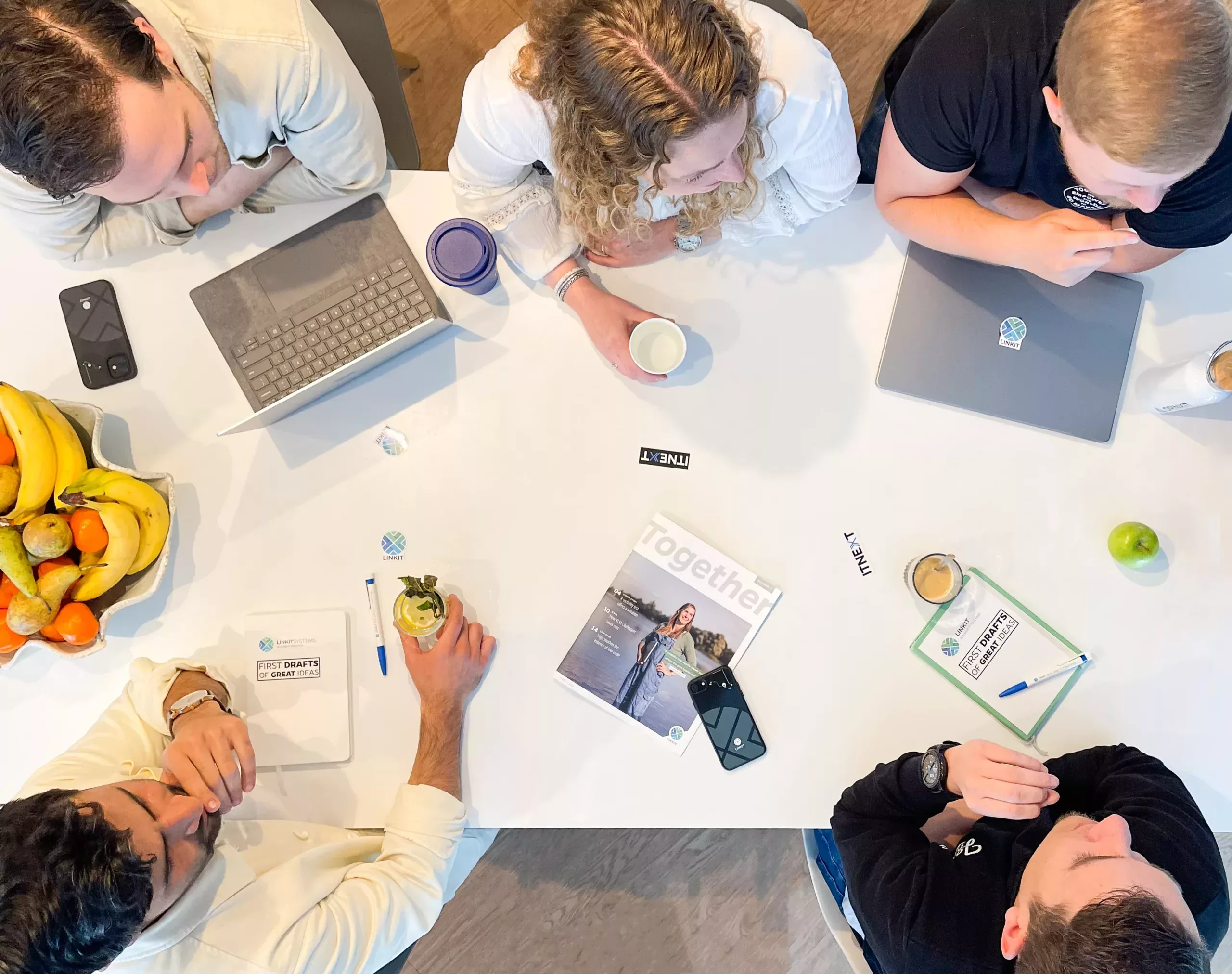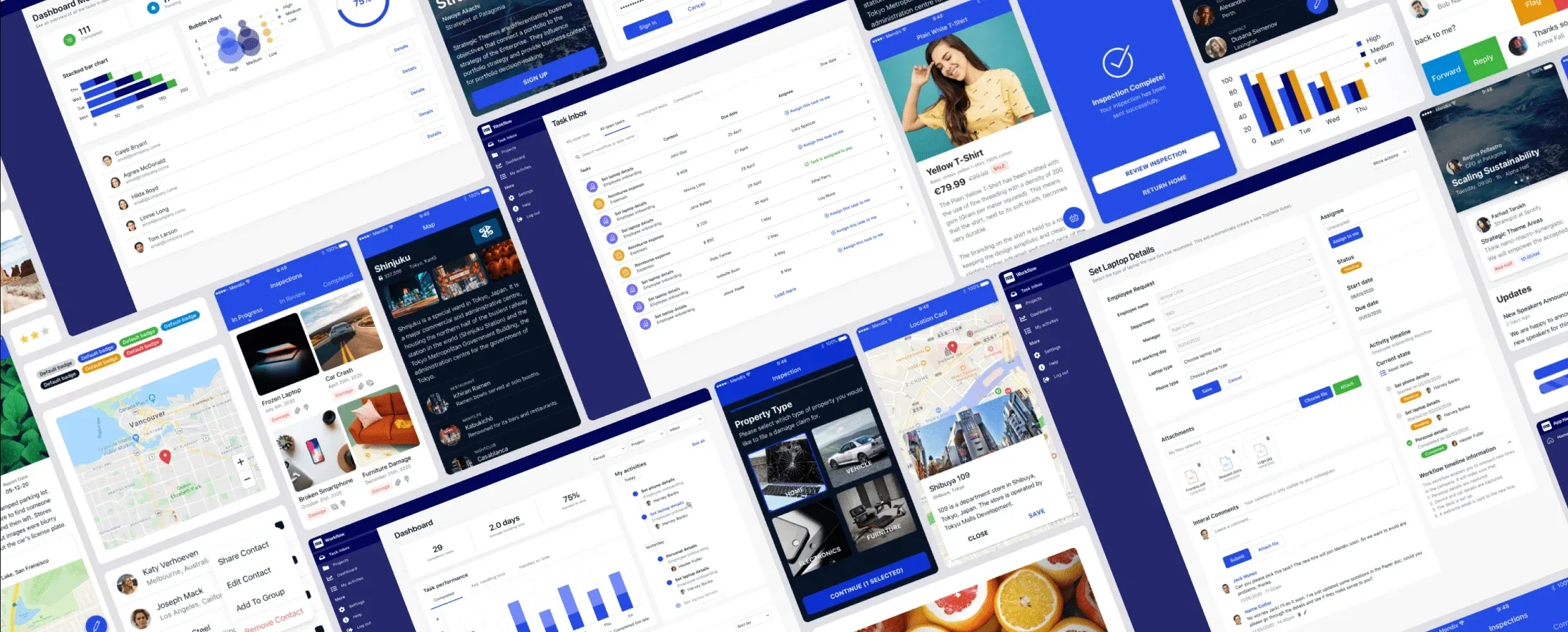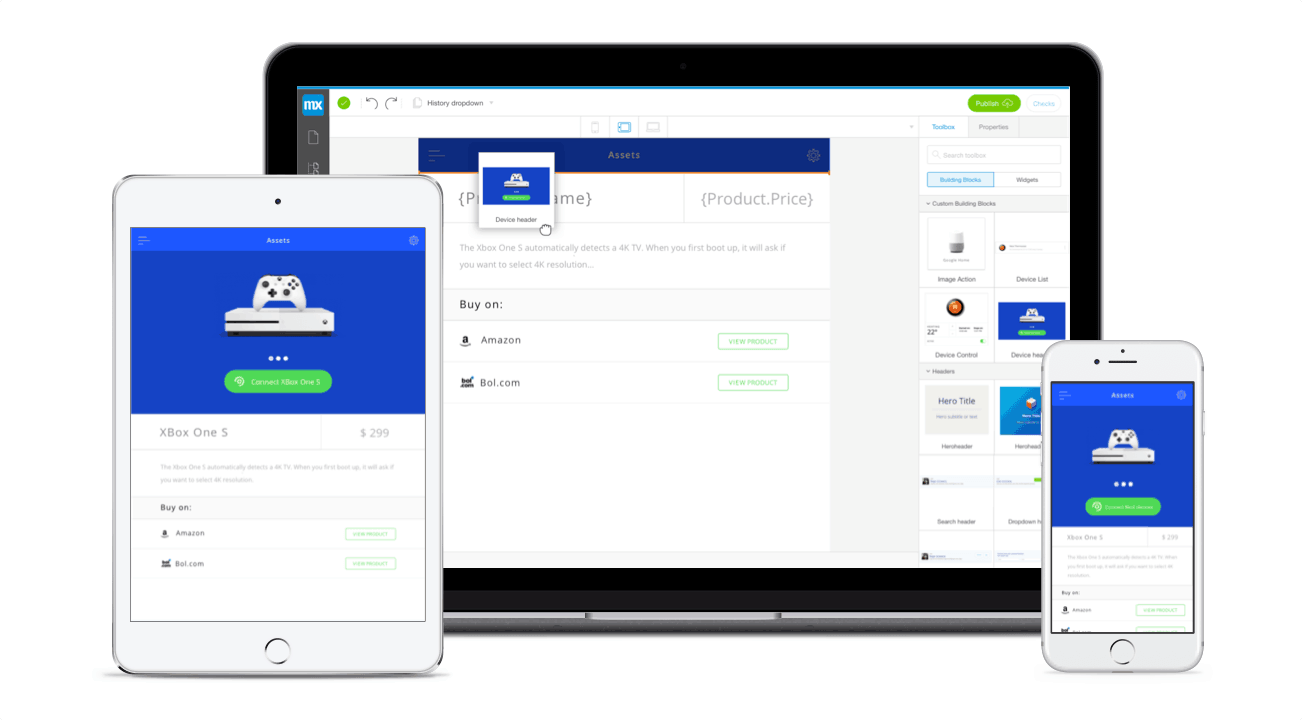
Successful app development? Here’s how you do it
Complete guide for app development
In the current digital era, apps are indispensable. They are an integral part of our daily lives and significantly impact the business world. Not limited to just mobile apps, the influence of business applications extends to all aspects of organizations’ IT environments. But app development, how do you do it?
In this article, we shed light on everything related to app development. We examine the central role of applications in digital transformations and (data-driven) decision-making, provide a step-by-step overview of the development process, compare programming methods (the traditional high-code and the progressive low-code), and present best practices and strategies that contribute to successful app development. In short: a comprehensive guide that provides valuable insights and practical knowledge to develop successful apps.

1. The business impact of apps
Rapid information flows and a growing dependence on technology characterize our world. Applications are indispensable and have significantly simplified how we perform tasks and share or acquire information.
But it’s not just on a personal level that apps are prevalent; also in the business domain, applications form the beating heart of modern operations. They are the driving force behind the digitalization of organizations, supporting them to adapt to changing market and customer demands, as well as technological trends.
(Custom) applications generate a wealth of data companies can use for customer and market analyses and ultimately decision-making. Therefore, the exponential growth of technologies has led to a shift towards data-driven strategies in various sectors, where real-time data is collected and analyzed. Valuable data that enables companies to stay one step ahead of their competition.
Applications influence:
- Efficiency and productivity
- Business apps automate processes and repetitive tasks, leading to an improvement in operational efficiency (such as SAP Business One);
- Workflow management applications streamline tasks and reduce lead time (such as ServiceNow).
- Data-driven decision-making
- Analytical apps provide deep, real-time insights into data. These dashboards and reports then facilitate decisions based on data (“data-driven decisions”).
- Customer relationship management (CRM)
- CRM applications consolidate real-time customer information and improve customer interaction (for example, Salesforce).
- Communication
- Chat and messaging apps accelerate internal communication and information exchange (such as Slack);
- Real-time collaboration between teams, regardless of the location of the involved parties (such as Microsoft Teams).
- Innovation and competitive capability
- Apps stimulate innovation by facilitating new ideas and processes;
- Organizations with innovative applications can gain a competitive advantage.
In essence, we can state that apps play an undeniably important role in how we live and work. They have fundamentally changed how industries and sectors operate and how society functions. The ability to quickly respond to (market) changes and technological advancements depends heavily on the effectiveness of developed applications within an organization. Apps are far from a temporary trend but rather an integral part of the current (digital) world.
“Apps are far from a temporary trend, but rather an integral part of the current (digital) world.”

2. The app development process
Developing a successful app is an iterative process, meaning it’s always possible to return to previous stages to make adjustments based on user feedback, market trends, and technological developments. The success of an application depends on its flexible capacity and ability to adapt to changing circumstances (scalability).
App development begins with an idea and ends with a well-functioning app. By carefully going through each step in the process and continuously learning from feedback and analysis, a product is created that is capable of responding to changing market and user needs and adapting to the organization.
2.1. Conceptualization
The first step in app development is elaborating on an idea. Ask yourself critical questions such as:
- What do you want to achieve with your app?
- How unique is the idea?
- Who is your target audience/who are the users?
- What functionalities should the app have?
- What will the app look like in broad strokes?
- On which devices should the app run?
- How much time and budget is available?
It also helps to conduct thorough market analysis and target audience research beforehand. This way, you gain a clear understanding of your idea and lay the groundwork for the rest of the development process.
2.2. Functional design (UI)
After you have further outlined your idea, it’s time for the functional design and the associated wireframes (simply put, the blueprint). During this step, the UI phase, the focus is on the app’s features. Ask yourself questions such as:
- Which functionalities do you want to incorporate?
- How does the app work exactly?
- What transitions exist between screens and how is navigation handled?
- How is the user-friendliness?
- How does the app respond to intuitive interaction?
A design sprint can help with this (and the following) step. With this development method, you uncover the real question and arrive at the best solution in four or five days. This way, you immediately know if your functional and graphic design meets the expectations of your target audience/users.

2.3. Graphic design (UX)
As soon as you have the functional design outlined, it’s time to bring the visual identity of the app to life (the UX phase). Graphic design focuses on defining aesthetic aspects and the ultimate user experience. Important: reason from the user’s perspective and don’t just think of aesthetic design. For example, consider how users navigate and ensure consistent patterns already familiar to people.
The graphic design consists of:
- Branding (colors, typography, and other visual elements);
- A style guide, outlining the design rules to ensure consistent design across the app;
- Ensuring that the design aligns with the brand identity and is recognizable to users;
- Keeping the design process iterative (gather user feedback and iteratively refine the app based on it).
2.4. App development
After going through the previous steps, it is (finally) time to start building the app for real. In this step, you choose the programming language and the corresponding framework based on your target platform. Choices here include:
- Native (one platform)
- Hybrid (combination of native and web)
- Web (application that runs on a web browser)
- Cross-platform (developing apps for both iOS and Android as well as web using one programming language)
However, before you start building, we advise you to create an MVP (Minimum Viable Product). This is essentially the same app but in a minimal, streamlined form. This way, you can validate and extensively test the app first, without losing much time.
Have you fully developed your idea, but is the actual construction a step too far for you? At LINKIT, we can assist you with this. Our developers are proficient in all programming languages (see Chapter 3 Comparison: high-code vs low-code) and know the ins and outs when it comes to programming applications. This way, you save time and can quickly get started with your application. Get in touch.
2.5. Testing
The success of an app hinges on its actual usage. The testing phase is therefore a crucial step in the development process. During this phase, you ensure that the application is free of bugs, functions smoothly, meets the specified requirements, and is delivered with high quality.
Testing occurs in four ways:
- Functional testing
- All components, screens, navigation structures, and functionalities are reviewed in this process.
- Technical testing
- Are potential systems, servers, and databases correctly linked? How are the loading times? Is the coding consistent with the function?
- UATs (User Acceptance Testing)
- Intended users test the application to see if it meets their requirements. Are all desired features incorporated? Does the app contain bugs? Do all buttons work?
- Security audit
- The security audit is an analysis of the code, architecture, and design of the app to identify potential security risks and data breaches.
If the above tests reveal missing functionalities or (technical) bugs, you’ll return to step 2.4. (Development) to address them. Once the app runs smoothly, the security is well-tightened, and future users are satisfied, you can proceed to step 2.6., the launch.
2.6. The launch
The launch, that’s what it’s all about. But at the same time, this is also an exciting moment because everything you’ve been working hard on all this time becomes public. The launch therefore requires careful planning and strategy.
- Where do you want to publish the app (for example, on online marketplaces, Apple App Store, or Google Play Store)?
- How do you inform future users that the app is coming?
- When will you launch the app (Friday is often discouraged because of the upcoming weekend and any bugs that may consume your weekend)?
- How will you create buzz? What marketing campaigns are involved?
To maintain control over the launch, we recommend opting for a staged rollout. This means the app is gradually rolled out to a small group of users. This allows any bugs or issues to be addressed early on before the majority of the organization starts using the application.
If everything is working properly, it is important to announce the launch to the organization promptly and reiterate its added value. Of course, you also provide clear documentation and supportive support so that users can quickly get answers to any questions.
2.7. Maintenance and further app development
However, after the launch, the work doesn’t stop because the digital landscape is constantly evolving. Updates to operating systems, new devices, and technological developments require adjustments to your app. These changes increase the likelihood of bugs, non-functioning features, or security issues.
By continuing to collect user feedback and constantly monitoring and adapting the app, you keep your application active and improve the user experience. Additionally, you keep the app engaging for users by regularly adding improvements or new features.
3. Comparison: low-code VS high-code
When it comes to the actual construction of an application, as a developer, you have the choice between low-code and high-code. Both have their characteristics, benefits, and challenges, and which programming method you choose depends entirely on the desired app requirements, the knowledge level of the development team, and the long-term organization goals (what scalability and flexibility does the app require?).
3.1. Low-code: Mendix
Characteristics:
- Mendix utilizes visual modeling tools, enabling developers to build applications without extensive programming knowledge;
- Prototypes can be developed quickly, significantly shortening the time-to-market;
- Mendix supports scalable solutions, making this development option suitable for small businesses and large enterprises with growth ambitions.
Advantages:
- Fast development time: Visual modeling and RAD principles (Rapid Application Development) accelerate the development process;
- Accessibility: The visual aspect makes Mendix accessible to developers without extensive programming knowledge;
- Scalable and flexible, for growing or changing needs;
- Low maintenance costs: Due to the simple implementation, teams can quickly respond to changes and updates;
- Huge community and knowledge base.
Disadvantages:
- Less control: Developers with a deep programming background may perceive the lack of hardcore code as limiting.
Reading tip: In this article, we’ll show you how to easily create a functional app based on an Excel file, without the need for technical code language. This allows you to take the first step in streamlining a (work) process efficiently based on an app.

3.2. Low-code: OutSystems
Characteristics:
- OutSystems, like Mendix, uses RAD principles (Rapid Application Development), speeding up development and implementation;
- Integration capabilities: seamless integration with existing systems and data sources;
- Scalable and flexible, for growing or changing needs.
Advantages:
- Fast development, thanks to RAD principles;
- Wide integration capabilities, making OutSystems suitable for companies with complex IT infrastructure;
- Support for mobile development and cross-platform development;
- Huge community and knowledge database.
Disadvantages:
- Learning curve: although OutSystems is accessible to everyone, it may take some time for developers to fully harness the platform’s power.
- Costs can be higher for relatively small projects.

3.3. High-code
Characteristics:
- In high-code development, applications are manually written in programming languages;
- Developers have full control over the code(s) and can implement complex functionalities;
- High-code supports various programming languages for app development, such as Java, C#, and Python.
Advantages:
- Full control: developers have a complete grip on the architecture and implementation.
- Flexibility and adaptability: suitable for projects with complex requirements.
- A large ecosystem of developer tools.
Disadvantages:
- Longer development time, because handwritten code takes more time;
- Deep programming knowledge is required, making it less accessible to developers with less substantive programming knowledge;
- Higher (maintenance) costs, as updates and modifications are more complex;
- Difficult to achieve, due to the shortage of technically qualified personnel.
4. Best practices and strategies for app development
No matter how well your app is technically built: its success depends on many more factors than just the code. A thoughtful design, a seamless user experience, optimal performance, and robust security are essential. Therefore, effective project management and smooth collaboration within development teams are crucial.
“The success of a developing application depends on many more factors than just the code.”
Apply the following best practices to lay a solid foundation for successful application development. After all, it’s not just about building a functional application, but also about creating a positive user experience that strengthens the business and can grow with the organizational and market needs.
Design and user experience
- User-centered design
- Start with user research to understand the needs. Create personas to define the target audience and test prototypes with real users to collect data and feedback;
- Intuitive navigation
- Minimize the number of clicks to reach a function and ensure consistent navigation elements and patterns;
- Responsive design
- Optimize the design for various screen sizes and devices. Use flexible grids and images to enhance the user experience;
- Prioritize accessibility
- Ensure the application is accessible to people with different abilities and limitations. Use clear and high-contrast colors and provide alternative text for images.
Optimization and performance
- Efficient resource utilization
- Minimize the use of server resources by implementing caching and optimizing images and videos for faster loading times;
- Code optimization
- Avoid excessive nesting and redundancy in the code. Implement asynchronous processes to increase responsiveness and do not require an immediate response;
- Use of Content Delivery Networks (CDNs)
- Implement CDNs to deliver static files faster and reduce server distance to the user for lower latency;
- Real-time monitoring
- Use monitoring tools to identify performance issues and analyze user behavior to locate bottlenecks.
Security
- Data encryption
- Encrypt sensitive data during transmission and storage, and implement HTTPS to secure communication;
- Use of secure authentication methods
- Implement two-factor authentication (2FA) for additional security and use tokens for authentication and authorization;
- Regular security checks
- Conduct regular penetration tests to identify vulnerabilities and keep frameworks and libraries up-to-date for security patches.
Project management and teamwork
- Agile
- Implement the Agile methodology for flexible and iterative developments. Work in sprints with clear goals and deadlines;
- Effective communication
- Utilize communication tools for efficient collaborations and organize regular meetings to discuss progress;
- Clear objectives and requirements
- Set clear, measurable goals for each development phase. Document comprehensive requirements to prevent misunderstandings;
- Continuous Integration and Continuous Deployments (CI/CD)
- Implement CI/CD pipelines (automating code changes) for automatic tests and deployments, and minimize manual errors by using low-code solutions;
- Flexible team structure
- Create multidisciplinary teams with diverse expertise and encourage knowledge sharing to strengthen the team.

5. Conclusion app development
App development is not just a technological investment; it is a strategic move to make your organization future-proof and progressive. An indispensable tool for companies aiming for growth and sustainable success in the rapidly changing (digital) world.
Its benefits extend across various aspects of business operations. Applications contribute to improved (process) efficiency, streamlined workflows, and the automation of repetitive tasks, simplifying work. But it’s not just internal processes that are optimized; apps also have a huge impact on the customer side. Investing in quality app development optimizes the relationship and interaction with your customers and reduces the distance between the market and your business. This enables you to adapt to the continuously changing digital landscape, making your company future-proof.
Want to develop an app?
This comprehensive article gave you insight into every aspect of app development. Whether you’re at the beginning of your career as an app developer, looking to build your application as a company, or an experienced developer, with this informative guide, you have all the necessary information at your fingertips.
However, you may have questions about low-code development or complex IT issues with specific requirements. Our development and IT experts are ready to assist you in finding the best solution for your question or problem.

Justin Bunnik

